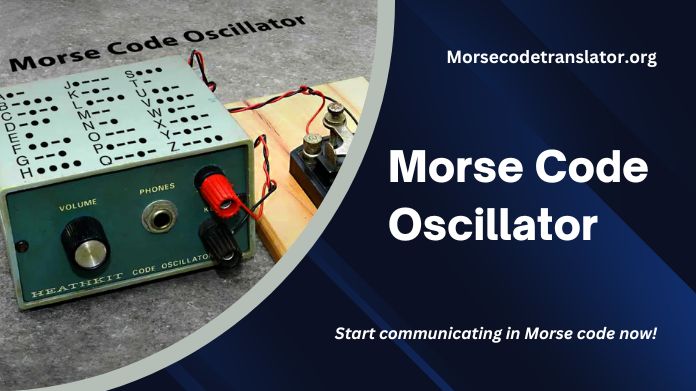Morse code, with its simple yet effective system of dots and dashes, has played a significant role in communication for over a century. While modern technology has largely replaced Morse code with digital communication methods, enthusiasts and hobbyists still appreciate the elegance and utility of this timeless language.
In this Morse Code Translator guide, we’ll explore how to make a Morse code oscillator or telegraph machine, allowing you to quickly transmit and receive Morse code messages.
Whether you’re a Morse code enthusiast, a DIY enthusiast, or simply curious about the mechanics of telegraphy, building your own Morse code oscillator can be a rewarding and educational experience.
Join us as we delve into the fascinating world of Morse code and learn how to construct your own Morse code oscillator from scratch.
What is a Morse Code Oscillator?

A Morse code oscillator is a device used to generate and transmit Morse code signals. It typically consists of an electronic circuit that produces audio tones corresponding to the dots and dashes of Morse code. Morse code oscillators are commonly used by amateur radio operators, enthusiasts, and hobbyists for communication and experimentation.
The oscillator circuit is designed to generate two distinct audio tones: one for dots (short signals) and another for dashes (long signals). By pressing a key or switch, the operator can control the duration and sequence of these tones, allowing them to transmit Morse code messages over radio waves or through other mediums.
Morse code oscillators come in various forms, from simple DIY projects built using essential electronic components to more sophisticated commercial units with additional features and functionalities. Regardless of the complexity, the primary purpose of a Morse code oscillator is to facilitate the transmission of Morse code messages reliably and efficiently.
How to Make a Morse Code Oscillator/ Telegraph Machine?
Making a Morse code oscillator or telegraph machine can be a fun and rewarding DIY project. Here’s an essential guide to help you get started:
1. Gather Materials and Components: You’ll need essential electronic components such as resistors, capacitors, transistors, and an audio speaker. Additionally, you’ll require a power source, a key or switch for input, and a casing or enclosure to house the circuit.
2. Design the Circuit: Design a simple oscillator circuit that generates audio tones corresponding to dots and dashes of Morse code. You can find circuit diagrams and schematics online or in electronics textbooks. Ensure the circuit is designed to produce distinct tones for dots (short signals) and dashes (long signals).
3. Assemble the Circuit: Use a breadboard or soldering iron to assemble the electronic components according to the circuit diagram. Follow proper safety precautions and soldering techniques to ensure a reliable connection.
4. Test the Circuit: Once assembled, ensure it generates the desired audio tones when the key or switch is pressed. Adjust component values or circuit configurations as needed to achieve the desired functionality.
5. Build the Enclosure: Construct or repurpose a suitable enclosure to house the circuit and provide protection and stability—drill holes for the key or switch, audio speaker, and other components.
6. Finalize and Test: Install the circuit into the enclosure and connect all components according to the circuit diagram. Test the Morse code oscillator to ensure it operates correctly and reliably.
7. Add Optional Features: Depending on your preferences and skills, you can add optional features such as volume control, tone adjustment, or LED indicators for visual feedback.
8. Enjoy and Experiment: Once your Morse code oscillator is complete, enjoy using it to transmit and receive Morse code messages. Experiment with different components and configurations to customize and enhance its functionality.
Remember to take your time, follow safety approaches, and enjoy the process. Building a Morse code oscillator is a great way to learn about electronics and communication while honing your Morse code skills.
Final Note
Building a Morse code oscillator or telegraph machine is a rewarding DIY project that combines electronics, craftsmanship, and communication skills.
By gathering materials, designing and assembling a circuit, and constructing an enclosure, you can create a functional device capable of transmitting and receiving Morse code messages.
Whether you’re a beginner hobbyist or an experienced electronics enthusiast, making a Morse code oscillator allows you to learn and experiment with basic electronic principles while exploring Morse code’s rich history and practical applications.
Once completed, your Morse code oscillator can serve as a versatile tool for communication, education, and experimentation. So, roll up your sleeves, dive into DIY electronics, and enjoy the satisfaction of building your own Morse code oscillator.
